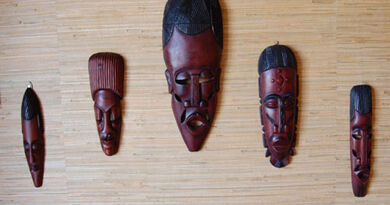Carnival of Saint-Pierre antan lontan
The famous Carnival of Saint-Pierre was not buried under the ashes. After the eruption of Pelée, it is now all of Martinique that celebrates its Carnival. Between the profusion of colors and costumes of the groups parading on the floats, the flamboyant dancing evenings, the crazy rhythms of the empties and groups on foot, the Martinique carnival invites to a journey of the senses in the limbo of this pagan festival. Beyond pure distraction, travesties and parties represent a kind of sacred dream, of abandonment, in the tumult of sounds and rhythms, in the presence, proximity and fusion of bodies. It is this properly initiatory experience that invites, day and night during the fat days, the Martinique Carnival.
On slave ships Carnival is constantly restrained by those terrified by the popular impatience it supposes, even if those who practice it are not always necessarily aware of it. During the Middle Ages, the Catholic Church, while tolerating, for want of being able to do otherwise, these amusements (inherited, in a syncretism of rare complexity, both bacchanalia, saturnalia, ancient lupercalia, great festivals Celtic and Gallic calendars, peasant propitiatory rites, etc.), has always endeavored to control them.
But the religious authorities are not the only ones involved. Civil authorities have also tried to control it, more subtly, by organizing it themselves. Carnival also responds, beyond pure distraction, to the need to escape from a universe, by finding in the inversion of the mask the possibility of being other.
The Africans transported to the Antilles were moreover initiated into the European carnival much earlier than one generally thinks, on the slave ships themselves.
It turns out that, on slave ships, the need to distract future slaves from time to time, to make them exercise led the victims of trafficking to participate, obviously in small groups , to these rejoicings.
In homes The custom of Carnival in the Antilles was introduced by French Catholics who used to have a good time before facing the rigors of Lent. The residences of the rich settlers were then the scene of lavish receptions, where the guests appeared masked and sported luxurious clothes.
Later, on their side, the slaves met in their neighborhood, imitating their masters as best they could. But as in art, music, dance and speaking, they introduced into their events the original elements they had, thus creating a very specific, very special carnival that they marked with their claw. They introduced the music of their drums, their beliefs, their cheeky and satirical temperament.
Many masters authorized the slaves to organize on the house, and exclusively on the house of course, their own carnival. The processions and collective dances, the musical parades of Nègres were always prohibited by the governors apart from the private properties, and this until the abolition of slavery.
Over time and events, the Martinican carnival had its ups and downs and even eclipses. However, when in 1848 slavery was abolished, the carnival was definitely marked by the contributions of former slaves. The scenes of the cane cutting parodyed their old profession and ridiculed it.
Carnival events in Fort de France Fort-de-France was slow to take over because the elite and good society shunned these popular festivities and spoke of them with disdain. In Fort-de-France, which was the government town, a town of garrisons, soldiers, sailors and gendarmes, the petty bourgeoisie seemed fearful of happening. At that time, in the chief town, everything was militarized, the official receptions, public celebrations, religious ceremonies, even processions, etc. The population of Saint-Pierre had never experienced coercion, fear of the gendarme, or government pressure up close. She had always galloped without martingale according to her whims. But her whims never led her to the brink of the abyss, because Nature had endowed her with admirable qualities.
Then it’s the Vide which will surge with a thunderous noise over the sleeping city! What picturesque and amusing scenes which unfolded I saw old women, book of mass and rosary in hand, going towards the cathedral to attend the first mass, to throw or be carried away in the whirlwind of this gymnastics, more select, more aristocratic than Vidé de Bagoë.



